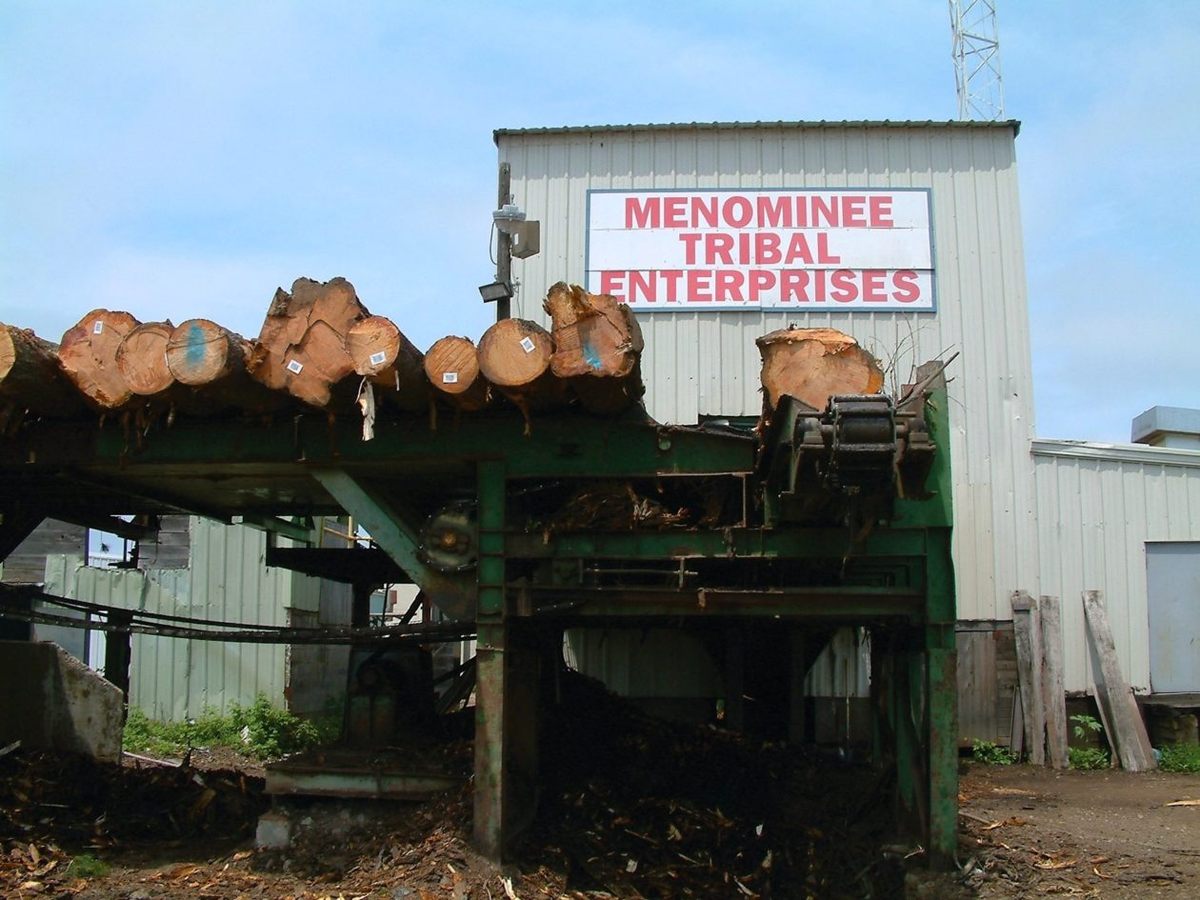In Wisconsin, the Menominee Tribe’s Sustainable Forestry Is Visible From Space
Wisconsin's Menominee Tree Keepers Practice Sustainable Forestry ... Atlas Obscura


Timber Harvest Administrator Oversees Sustainable Logging on Menominee Indian Reservation
Mike Lohrengel looks up in awe at trees he has known for 30 years. “This is one of the most beautiful places I know. This forest has it all: the most species, the most diversity. Many trees I know individually. Look at this one behind us. It’s got a split way up there. I’ll never forget that tree till I die.”
The Sustainable Development Goals (SDGs)
- Goal 15: Life on Land – Protect, restore, and promote sustainable use of terrestrial ecosystems, sustainably manage forests, combat desertification, and halt and reverse land degradation and halt biodiversity loss.
It is a love affair, for sure. But Lohrengel is no tree-hugger, out to preserve a special, pristine place. He is a timber harvest administrator, overseeing logging in one of the most remarkable working forests in the United States—nearly a quarter-million acres of trees that occupy almost the entire Menominee Indian Reservation in northern Wisconsin.
“The forest looks pristine,” he says, as a flurry of snow falls through the open canopy. “These big maples and basswoods are around 150 years old. But we have been logging here for over a century, and we still have more trees than when we started.” In June, the tribe’s forestry officials began exploring the potential for selling the carbon accumulating in the forest on the U.S.’s growing market for carbon-offset credits.
Forest Management for Sustainable Development
- The Menominee forest is home to over a billion trees, making it one of the most diverse forests in the United States.
- The tribe practices sustainable forest management, selectively harvesting weak, sick, and dying trees while allowing healthy trees to grow and reproduce naturally.
- This approach has resulted in the forest having more trees now than when logging operations began over a century ago.

The trick, says Lohrengel, is husbandry for the long term. “We come in every 15 years, take out the weak trees, the sick trees, and the ones that are dying, but leave the healthy stock to grow some more and reproduce,” he says. “We don’t plant anything. This is all natural regeneration, and the way we do it the forest just gets better and better.”
Lohrengel is not a Menominee tribal member. He is the son of a pulp-mill worker who has been devoted to the tribe’s harvesting philosophy since first working on the reservation inventorying the trees in 1990. Most U.S. foresters, he says, are trained to cut the best trees and leave the sick ones behind. The result is a forest with deteriorating genetic stock. But the Menominee are “doing the opposite, and making the forest healthier.”
“We make our decisions based on what’s best for the forest,” says Lohrengel’s boss, the Menominee’s veteran head forester Ron Waukau. “Our logging schedules and management are purely for the forest. I am really humbled to be able to work like that. The sawmill knows what it will get and sells accordingly.”
For the Menominee, says head silviculturist Tony Waupochick, it is not just a matter of maintaining the volume of timber. “We are also managing the forest to maintain its diversity and integrity, and to keep it healthy for wildlife.”
The Menominee adopted their enlightened approach soon after the creation of the reservation in 1854. It has worked spectacularly well, says Patrick McBride, sales director of the Pennsylvania-based lumber company MacDonald & Owen, which buys most of the output from the Menominee sawmill. In almost 170 years, the tribe has harvested nearly twice the forest’s former volume of timber, yet it still has 40 percent more standing wood than when they started. “And by leaving the best trees, the old and sick lumber they harvest is now better than the best from most everyone else,” says McBride, who pays a premium price for it.
Professional U.S
SDGs, Targets, and Indicators
1. Sustainable Development Goal: SDG 15 – Life on Land
– Target 15.2: By 2020, promote the implementation of sustainable management of all types of forests, halt deforestation, restore degraded forests, and substantially increase afforestation and reforestation globally.
– Indicator 15.2.1: Progress towards sustainable forest management.
2. Sustainable Development Goal: SDG 13 – Climate Action
– Target 13.2: Integrate climate change measures into national policies, strategies, and planning.
– Indicator 13.2.1: Number of countries that have integrated mitigation, adaptation, impact reduction, and early warning measures into their national policies, strategies, and planning.
3. Sustainable Development Goal: SDG 8 – Decent Work and Economic Growth
– Target 8.5: By 2030, achieve full and productive employment and decent work for all women and men, including for young people and persons with disabilities, and equal pay for work of equal value.
– Indicator 8.5.1: Average hourly earnings of female and male employees, by occupation, age group, and persons with disabilities.
Table: SDGs, Targets, and Indicators
| SDGs | Targets | Indicators |
|---|---|---|
| SDG 15 – Life on Land | Target 15.2: By 2020, promote the implementation of sustainable management of all types of forests, halt deforestation, restore degraded forests, and substantially increase afforestation and reforestation globally. | Indicator 15.2.1: Progress towards sustainable forest management. |
| SDG 13 – Climate Action | Target 13.2: Integrate climate change measures into national policies, strategies, and planning. | Indicator 13.2.1: Number of countries that have integrated mitigation, adaptation, impact reduction, and early warning measures into their national policies, strategies, and planning. |
| SDG 8 – Decent Work and Economic Growth | Target 8.5: By 2030, achieve full and productive employment and decent work for all women and men, including for young people and persons with disabilities, and equal pay for work of equal value. | Indicator 8.5.1: Average hourly earnings of female and male employees, by occupation, age group, and persons with disabilities. |
Explanation:
1. SDG 15 – Life on Land is addressed in the article as it discusses the sustainable management of forests and the preservation of biodiversity.
2. Target 15.2 is relevant as it focuses on promoting sustainable forest management, halting deforestation, and increasing afforestation and reforestation.
3. Indicator 15.2.1 can be used to measure progress towards sustainable forest management.
4. SDG 13 – Climate Action is connected to the article as it mentions the potential for selling carbon offsets generated by the forest’s carbon accumulation.
5. Target 13.2 is applicable as it emphasizes integrating climate change measures into policies and strategies.
6. Indicator 13.2.1 can be used to measure the integration of mitigation and adaptation measures into national policies and strategies.
7. SDG 8 – Decent Work and Economic Growth is relevant as it discusses the economic activity and employment generated by the Menominee forest.
8. Target 8.5 is applicable as it focuses on achieving full and productive employment and decent work.
9. Indicator 8.5.1 can be used to measure the average hourly earnings of employees.
The table summarizes the identified SDGs, targets, and indicators based on the analysis of the article.
Behold! This splendid article springs forth from the wellspring of knowledge, shaped by a wondrous proprietary AI technology that delved into a vast ocean of data, illuminating the path towards the Sustainable Development Goals. Remember that all rights are reserved by SDG Investors LLC, empowering us to champion progress together.
Source: atlasobscura.com

Join us, as fellow seekers of change, on a transformative journey at https://sdgtalks.ai/welcome, where you can become a member and actively contribute to shaping a brighter future.







